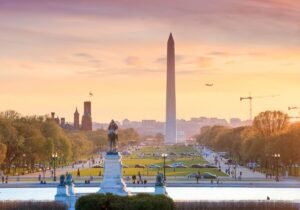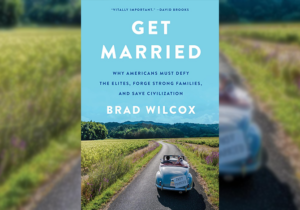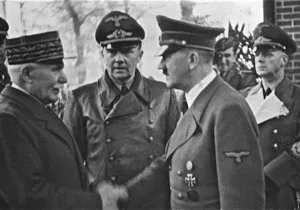The picture went around the world: a face-painted, bare-chested, spear-carrying man, covered in tattoos, wearing animal skins and Viking-style animal horns, stood on the dais of the US Senate and shouted “Where’s Pence? Show yourself.” Jacob Angeli Chansley, a self-declared “ordained shamanic practitioner” and leading voice of in the far-right QAnon conspiracy theory movement, has for many observers become an epitome of the pro-Trump riots that sowed death and destruction in the US Capitol on January 6—even if it appears that he remained non-violent himself. However, the image of a neo-pagan shaman in Viking veneer, standing in the inner sanctum of US democracy, also symbolized another more gradual but no less consequential watershed in American politics: the shift from a primarily conservative and faith-driven religious right to an increasingly revolutionary and race-driven post-religious right.
The idea of the secularization of America’s right might sound surprising, given the ostentatious presence of Christian symbols, rhetoric, and references at the riots. Indeed, observers like Mark Melton, David French, Emma Green, and others all rightly point out that, based on the information available, conservative evangelical Christians seemed strongly represented during the protests. Even if it is unclear how present Christians were in the storming of the capitol (so far most identified rioters appeared to be—like Chansley—either openly non-Christian or without strong links to Christian communities), there is so far no evidence of Christian demonstrators in any way trying to moderate their fellow protestors, either. On the contrary, authors have repeatedly pointed to the role of Christian Nationalism in fueling this new radical and extremist right.
Still, a closer look reveals that the balance of power within the American right has radically changed in recent years. No longer are the Republican grassroots characterized by “suburban mums” who, fired up by charismatic evangelical preachers, take to the streets or school boards to defend their children’s right to a Christian education, or to request the return of higher ethical standards to public office. No longer are churches, congregational mailing lists, and para-church organizations the epicenter of conservative mobilization. No longer does the Christian right determine Republican candidates in the primaries. What we see instead are suburban mums being replaced by “Proud Boys” and online communities; sermons of mega-church preachers being replaced by the conspiracy theories of QAnon; the Moral Majority and the Christian Coalition being replaced by Donald Trump’s hardcore base as GOP kingmakers.
This gradual shift from the religious to the post-religious right is neither completely new nor limited to the American experience. Over the last four years, I have conducted an in-depth research project on the relationship between religion and the rise of right-wing populism in Western democracies, interviewing over 125 right-wing populist leaders, mainstream politicians, and faith leaders in Germany, France, and the United States. One key finding of this research was that there is a growing schism among right-wing voters in Western democracies between the old traditional religious right and a new, more secular right. Broadly speaking, the former is composed of the church-going and more educated middle classes, committed to socially conservative church teachings. But they are also open to immigration and attached to traditional conservative parties and candidates. By contrast, the new secular right typically consists of disenchanted working-class voters who combine secular values with cultural nativism and authoritarian tendencies, have less allegiance to church teachings, and look more favorably on more radical right-wing populist policies and candidates.
To be sure, the boundaries between these two are blurry. For instance, as discussed in a conversation with Mark Melton for Providence last year, many proponents of the new right are what scholars have come to call “cultural evangelicals.” These individuals might still culturally and politically identify as evangelicals and embrace a secularized form of Christian nationalism, but they have grown increasingly estranged from evangelical practices, communities, and beliefs.
However, a strikingly consistent observation across Western democracies is that the more distant such voters grow from religious community life and practice, the more open they become toward the white identity politics of the populist right. While in Europe scholars observed a “religious vaccination effect” against right-wing populism, in the US the Cato Institute’s Emily Ekins also found that “religious participation may have a moderating effect on politics, particularly on matters of race, immigration, and identity”—the very signature topics of white nationalist groups.
In Europe this socio-demographic and attitudinal divergence between the religious and the secular right is reflected in political voting behavior. Right-wing populist parties become increasingly secular in their policies and often perform best among irreligious voters, while Christian voters remain largely distanced. But in America, the old religious right seems to have entered an electoral pact with the new secular right.
From the side of the post-religious right, the benefits of such a pact are obvious. Its coalition has conservative Christians as junior partners, who provide a powerful financial and electoral resource, and a convenient fig-leaf of respectability. Meanwhile, crosses and crusader narratives are useful symbols for memes and demonstrations. But make no mistake, Christian conservatives are no longer the agenda setters in this new right. In this movement, participants do not embrace Christianity as the living, vibrant, universal, and increasingly diverse faith in Jesus Christ that the overwhelming majority of America’s churches practice today. Instead, the extreme form a secularized Christianism as a symbol of a white and masculine past was on display on January 6. Just like the Vikings, the crusaders, or the Confederacy, Christianism in this context is little more than an ethno-cultural identifier that is increasingly dissociated from Christian theological beliefs, Christian private ethics, or Christian institutions like the church.
Such a hollowed-out kitsch-Christianity is not very demanding. It allows one to tolerate or indulge in white nationalist resentment even if the Gospel is clear in its universalism; it allows one to make exceptions for the outrageous public behavior of a Donald Trump even if for decades the Christian right had called for higher standards of ethical behavior for politicians; it allows one to turn a deaf ear to clergy and faith leaders who increasingly and vehemently condemn the radical right. In this thinned-out version, secularized Christianism then also becomes compatible with conspiracy theories like QAnon, with white supremacist groups like the Proud Boys, the neo-pagan symbolism of shamans and Vikings, as well as with the slavery cause of the Confederacy. In fact, kitsch-Christianity finds much more inspiration from the pagan romanticism for a lost cause and death in glory, than by the Christian hope for redemption and life after death.
It is therefore not surprising that, even as they embrace the very ethics of unconstrained power that Christianity had sought to tame in pre-Christian Europe, QAnon conspiracy theorists, Proud Boys, and other far-right extremist were happy to parade Christian crosses and flags alongside Viking and neo-pagan imaginary during their storming of the Capitol.
What is more surprising, however, is that many serious Christians at the protests and elsewhere around the country seemed unbothered or even supportive of this idolatrous use of their faith. Many privately maintain that the alliance with Trumpist or even more radically right-wing politics is a necessary evil in exchange for a policy agenda that caters to their preferences with regards to abortion, gay marriage, and religious freedom. As Finbar Curtis has pointed out, in a way, by doing so many conservative Christians are doing exactly what many secular liberals have asked them to do for decades: they dissociate politics from private religious ethics and beliefs. However, in light of the deadly events at the Capitol, it might be worth considering whether they can still control the demons they have unleashed. In Johann Wolfgang von Goethe’s masterwork Faust, the protagonist, driven by a desire for earthly gains and power, enters a bargain with a bare-chested demonic creature wearing horns and animal skins that ends up costing him not his life but his soul. The QAnon shaman in the Capitol was certainly no Mephistopheles, yet a bargain with the brand of post-religious far-right politics that he has come to represent might entail a similar cost for America’s Christians.







 Sponsor a student for Christianity & National Security 2024
Sponsor a student for Christianity & National Security 2024